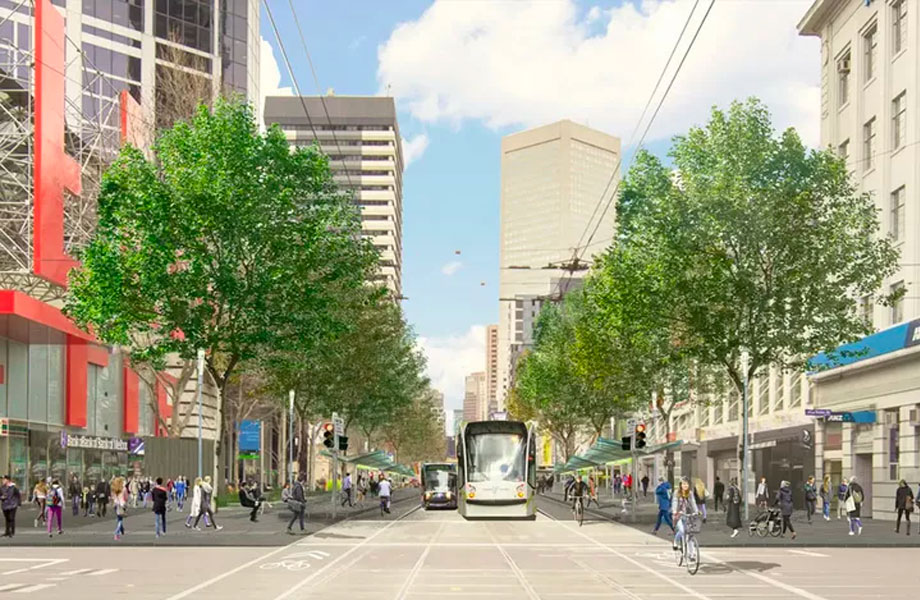Council Backs Plan to Curb Cars and Pedestrianise CBD
A proposal to pedestrianise sections of Elizabeth Street, one of Melbourne’s most significant city streets, will be rolled out in stages over the next six years after city councillors voted unanimously for the plan on Tuesday.
The proposal, part of the Elizabeth Street Strategic Opportunities Plan, will see cars and trucks banned between La Trobe and Little Lonsdale streets and Little Bourke and Bourke streets.
The Future Melbourne Committee voted in favour of its adoption at a meeting on Tuesday, calling for changes to prioritise pedestrian, bicycle and public transport traffic.
Under the new plan, Elizabeth Street would be closed to cars between Bourke and Little Bourke streets and between Little Lonsdale and Latrobe streets.
Southbound traffic would be removed from the blocks between Little Lonsdale and Lonsdale streets, and Bourke and Little Collins Streets, and the area revitalised with widened bluestone footpaths, bike lanes and street furniture.

The announcement comes as the city grapples with a growing population with more than 900,000 people moving around the city each day – a figure set to increase to 1.4 million by 2036.
Surveys conducted by the City of Melbourne have found that 90 per cent of people travelling along Elizabeth Street either walk or catch a tram, with 3 per cent using bikes and 6 per cent vehicles.
A March 2018 study showed there were 1,147 pedestrians per hour using Elizabeth Street around Melbourne Central, higher than the 1,013 pedestrians using Swanston Street around Town Hall.
Yet, footpath width in Elizabeth Street is six metres compared to 14 metres in Swanston Street.
There have also been numerous collisions along Elizabeth Street, with over 95 incidents recorded over a five year period, and around 45 per cent of crashes involving either a cyclist or a pedestrian.
Related: Melbourne Gets its First Public Park in Almost 40 Years
The timeline
• May 2019: Council to consider Elizabeth Street Opportunities Plan.
• Early 2020: Stage one improvement works start on the southern end of Elizabeth Street from Flinders Street to Flinders Lane (already endorsed by Council).
• 2020-2021: If endorsed by Council — stage two improvement works for the middle section of Elizabeth Street to start (Little Collins Street to Little Bourke Street).
• 2026+ If endorsed by Council, Stage three construction works for northern end of Elizabeth Street to start (Lonsdale Street to La Trobe Street).
Council said the changes would improve safety and amenity of the street while also boosting retail traffic.
“As the gateway to Melbourne's retail and commercial heart, Elizabeth Street plays a key role in how visitors, residents and workers enjoy our city,” acting lord mayor Arron Wood said.
“We know that pedestrian flow is vital to our city economy.”
“In fact, studies show that a 10 per cent increase in walking connectivity in the Hoddle Grid is worth $2.1 billion in economic uplift.”
Aligned with the Draft Transport Strategy 2030, the number of on-street disability and loading parking spaces would be retained in alternate locations on Elizabeth Street, ensuring accessibility for businesses and those who need to travel to the city by car.
Work would not begin for at least two years and would have to go through a separate public consultation and approval process to go ahead.
Future construction of stage one if earmarked for early-2020, subject to funding and appropriate timing in relation to other major projects and works occurring around the city.

Melbourne's congestion-busting bike-friendly vision
Cyclists and pedestrians will get more space in Melbourne’s CBD and cars less under the city’s 10-year transport plan.
Vienna, which topped Melbourne as the world’s most liveable city last year, New York and Barcelona have been cited as the inspiration for the plan.
The draft strategy, released last month, has been developed over the past 12 months, proposing repurposing road space equivalent to 20 Bourke Street malls as areas for walking, cyclists, trade and other public purposes.
Under the plan, the number of bicycle lanes would increase from a total of 6km to more than 50km by 2030.
Council is also expected to roll out a 30km/h trial for cars in a section of the city and a congestion charge, two measures previously flagged in discussion papers released ahead of the strategy. The 30km/h would replace 40km/h zones.
It is also expected that on-street car parking will continue to be removed and given over to motorcycle parking, as a way of extending footpaths.
The council is already working with the state government to tweak traffic lights in favour of pedestrians at busy intersections such as the corner of Collins and Spencer streets.













